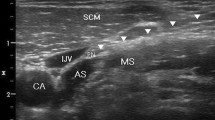Abstract
Background
Postlaparoscopic shoulder pain (PLSP) frequently occurs after various laparoscopic surgical procedures. Its mechanism is commonly assumed to be overstretching of the diaphragmatic muscle fibers due to the pressure of a pneumoperitoneum, which causes phrenic nerve-mediated referred pain to the shoulder. Based on this hypothesis, we speculated that during inspiration, the lung could squeeze out the phrenic nerve with carbon dioxide gas against the constantly pressurized abdominal cavity with increasing tidal volume (VT). Thus, we examined whether mechanical ventilation with a low VT (LTV, VT 7 ml/kg) during a pneumoperitoneum might reduce PLSP in patients undergoing laparoscopic appendectomy compared with ventilation with the traditional VT (TTV, VT 10 ml/kg).
Methods
In a prospective trial, 64 adult patients undergoing laparoscopic appendectomy were randomly assigned to two groups of 32 each (LTV and TTV groups). Intravenous ketorolac was used as a postoperative rescue analgesic. The 2-, 4-, 24-, and 48-h postoperative incidence and severity of PLSP, severity of surgical pain, and need for rescue analgesia was assessed.
Results
The overall incidence of PLSP was similar in both groups (57.1% in the LTV group vs. 65.5% in the TTV group). Compared with the TTV group, the incidence and PLSP verbal rating scale (VRS) did not decrease in the LTV group throughout the study period. No statistically significant differences were observed in the VRS surgical pain score, the cumulative ketorolac consumption at each time point, or the time to first rescue analgesia.
Conclusions
Mechanical ventilation with a reduced 7 ml/kg VT during a pneumoperitoneum does not reduce the frequency and severity of PLSP after laparoscopic appendectomy compared with ventilation with the traditional VT (10 ml/kg).


Similar content being viewed by others
References
Semm K (1983) Endoscopic appendectomy. Endoscopy 15:59–64
Garbutt JM, Soper NJ, Shannon WD, Botero A, Littenburg B (1999) Meta-analysis of randomized controlled trials comparing laparoscopic and open appendectomy. Surg Laparosc Endosc 9:17–26
Chung RS, Rowland DY, Li P, Diaz J (1999) A meta-analysis of randomized controlled trials of laparoscopic versus conventional appendectomy. Am J Surg 177:250–256
Golub R, Siddiqui F, Pohl D (1998) Laparoscopic versus open appendectomy: a metaanalysis. J Am Coll Surg 186:545–553
Dixon JB, Reuben Y, Halket C, O’Brien PE (2005) Shoulder pain is a common problem following laparoscopic adjustable gastric band surgery. Obes Surg 15:1111–1117
Mouton WG, Bessell JR, Otten KT, Maddern GJ (1999) Pain after laparoscopy. Surg Endosc 13:445–448
Berberoglu M, Dilek ON, Ercan F, Kati I, Ozmen M (1998) The effect of CO2 insufflation rate on the postlaparoscopic shoulder pain. J Laparoendsc Adv Surg Tech A8:273–277
Sarli L, Costi R, Sansebastiano G, Trivelli M, Roncoroni L (2000) Prospective randomized trial of low-pressure pneumoperitoneum for reduction of shoulder-tip pain following laparoscopy. Br J Surg 87:1161–1165
Chang SH, Lee HW, Kim HK, Kim SH, Kim DK (2009) An evaluation of perioperative pregabalin for prevention and attenuation of postoperative shoulder pain after laparoscopic cholecystectomy. Anesth Analg 109:1284–1286
Phelps P, Cakmakkaya OS, Apfel CC, Radke OC (2008) A simple clinical maneuver to reduce laparoscopy-induced shoulder pain: a randomized controlled trial. Obstet Gynecol 111:1155–1160
Matsui K, Yoshida M, Maemura Y, Ichihara Y, Yamagami M, Kikuchi H (1994) Significance of phrenic nerve block in the anesthetic management of laparoscopic cholecystectomy. Masui 43:1718–1721
Dogan R, Sahin D, Isbilen C (2008) Laparoscopic cholecystectomy under spinal anesthesia with right phrenic nerve block. Acta Anaesthesiol Scand 52:445–446
Tiel RL, Kline DG (1996) Peripheral nerve trauma. In: Bradley WG (ed) Neurology in clinical practice. Butterworth-Heinemann, Boston, pp 980–981
Song C, Alijani A, Frank T, Hanna GB, Cuschieri A (2006) Mechanical properties of the human abdominal wall measured in vivo during insufflation for laparoscopic surgery. Surg Endosc 20:987–990
Nyerges A (1994) Pain mechanisms in laparoscopic surgery. Semin Laparosc Surg 1:215–218
Aitola P, Airo I, Kaukinen S, Ylitalo P (1998) Comparison of N2O and CO2 pneumoperitoneum during laparoscopic cholecystectomy with special reference to postoperative pain. Surg Laparosc Endosc 8:140–144
Abbott J, Hawe J, Srivastava P, Hunter D, Garry R (2001) Intraperitoneal gas drain to reduce pain after laparoscopy: randomized masked trial. Obstet Gynecol 98:97–100
Cai H, Gong H, Zhang L, Wang Y, Tian Y (2007) Effect of low tidal volume ventilation on atelectasis in patients during general anesthesia: a computed tomographic scan. J Clin Anesth 19:125–129
Disclosures
Drs. Hwa-Yong Shin, Seong-Hyop Kim, Yeong-Ju Lee, and Duk-Kyung Kim have no conflicts of interest or financial ties to disclose.
Author information
Authors and Affiliations
Corresponding author
Rights and permissions
About this article
Cite this article
Shin, HY., Kim, SH., Lee, YJ. et al. The effect of mechanical ventilation tidal volume during pneumoperitoneum on shoulder pain after a laparoscopic appendectomy. Surg Endosc 24, 2002–2007 (2010). https://doi.org/10.1007/s00464-010-0895-3
Received:
Accepted:
Published:
Issue Date:
DOI: https://doi.org/10.1007/s00464-010-0895-3




